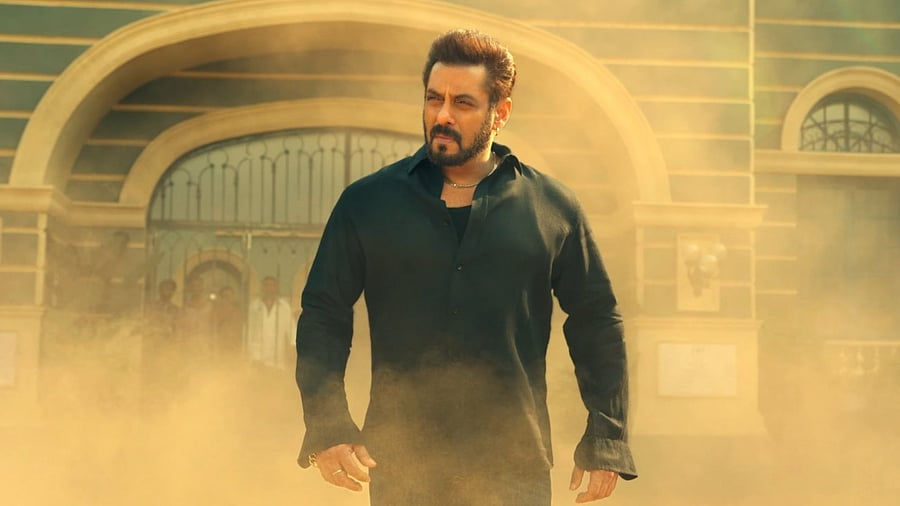
Salman Khan in a still from the movie Sikandar.
Credit: NGE Movies
Have you ever found yourself doomscrolling on one of those short-format video platforms, and the algorithm starts showing you excerpts from different, disjointed parts of the same movie until you can piece together exactly what the story is? “Sikandar,” directed by A R Murugadoss, unfolds on the screen exactly like that: Seemingly unconnected parts of a story appear in staccato bursts, expecting you — the viewer — to piece everything together and make sense of it all.
Now, this would have made for a great movie had the screenplay and the script been created with enough dots for us to connect and derive some coherence. Instead, what we get is 150 minutes of Salman Khan-worshipping clips — can’t call the entire thing a “tale” because that would be an insult to proper tales — that try to make a story out of a one-liner: Uber-rich golden-hearted widower tries to protect three recipients of his wife’s organs from a corrupt politician trying to avenge his perverted son’s self-caused death.
That is where the failure of “Sikandar” lies. And in doing so, it failed the hundreds — or maybe thousands — of people who put their blood, sweat, and tears into making this film. Sure, they got paid, but just to be associated with a movie that is more of a stain than an honest effort at cinema of any form.
On screen
I have said it more than once: Salman Khan may not be all that bad an actor, but his films stutter, stumble, and land on their face whenever the star in him overshadows that part of the overall performer. Thus, this festival-crowd-targeting offering feels about as hollow as the commercial screening I attended on Eid (March 31) morning: There were a grand total of five paying customers — including me — in the multi-screen theatre’s auditorium!
The other actors — as is usual in most of the recent Salman Khan films — take a back seat. Sharman Joshi is utterly wasted, while the likes of Sanjay Kapoor and Kajal Aggarwal have precious little to do. It seems there was a conscious decision to keep their characters one-dimensional, but I’ll visit that part in a bit. Meanwhile, Prateik Babbar and Sathyaraj appear to have delivered their performances with guns to their heads.
Pritam’s songs and Santhosh Narayanan’s score come across as pale imitations of the “mass” background music (BGM) and belters that the likes of Devi Sri Prasad and Anirudh Ravichander have been delivering across industries. Attempts to incorporate hip-hop and rap fall significantly short of elevating the BGM. The musical numbers act as convenient cigarette, snack, or bathroom breaks.
Behind the screen
In the absence of any details of what hampered A R Murugadoss behind the scenes, the blame for this electric-shock-to-the-brain of a film falls squarely on him: He not only directed it but was also responsible for the story and the screenplay!
As I mentioned earlier, the story can be summed up in a single sentence. Add to that the one-note characters for the most part (although Salman Khan’s Sanjay Rajkot gets some of them to have a change of heart, usually through sermon-like dialogues), and you have on your hands a surefire headache-inducer.
The only character that seemed somewhat interesting was Rani Sahiba or Srisai, played by Rashmika Mandanna. Yet, her steely grit, resourcefulness, and screen presence are all marred by the way she dies. It’s as if all her plot armour went to defending her husband, and even their backstory — which could have immensely helped make the couple easier to root for — is hinted at but fails to make it to the big screen.
Meanwhile, character motivations are sketchy at best, emotions and plot points are far from compelling, and the plot itself has enough holes to be used as a sieve for making tea! Honestly, some scenes are so mindless that they seem to have been included just to insult the viewer.
There’s not much by way of cinematography, and the dialogues, as already mentioned, fail to rouse any emotion, even though three different people — Rajat Arora, Hussain Dalal, and Abbas Dalal — are credited for it.
However, probably the most slapdash job seems to have come from editor Vivek Harshan. Given that he won the National Award for his work in 2014’s “Jigarthanda” and delivered the goods with last year’s “Manjummel Boys” and “Aavesham”, one has to assume something went really wrong behind the scenes for him to have delivered this dud.
Final verdict
This Salman Khan vehicle comes across as the brainchild of someone stuck in the 1980s, with sensibilities from that era bleeding into the film. I was — through my own fault — trapped on the other side of an emergency exit for 10-odd minutes while coming out from this film, and that felt more eventful than the entire two and a half hours of “Sikandar”.